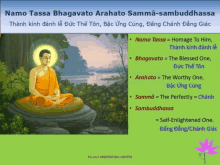Free Online FOOD for MIND & HUNGER - DO GOOD 😊 PURIFY MIND.To live like free birds 🐦 🦢 🦅 grow fruits 🍍 🍊 🥑 🥭 🍇 🍌 🍎 🍉 🍒 🍑 🥝 vegetables 🥦 🥕 🥗 🥬 🥔 🍆 🥜 🎃 🫑 🍅🍜 🧅 🍄 🍝 🥗 🥒 🌽 🍏 🫑 🌳 🍓 🍊 🥥 🌵 🍈 🌰 🇧🇧 🫐 🍅 🍐 🫒Plants 🌱in pots 🪴 along with Meditative Mindful Swimming 🏊♂️ to Attain NIBBĀNA the Eternal Bliss.
Kushinara NIBBĀNA Bhumi Pagoda White Home, Puniya Bhumi Bengaluru, Prabuddha Bharat International.
06/23/22
Filed under: General, Theravada Tipitaka , Plant raw Vegan Broccoli, peppers, cucumbers, carrots
Posted by: site admin @ 5:17 am
Posted by: site admin @ 5:17 am
LESSON 4473 Fri 24 Jun 2022
Daily Wisdom
DO GOOD PURIFY MIND
THERAVADA









THERAVADA
Wednesday, 29 February 2012
Teaching of the Elders
›
In the Buddhist countries of
southern Asia, there never arose any serious differences on the
fundamentals of Buddhism. All these countries -…
southern Asia, there never arose any serious differences on the
fundamentals of Buddhism. All these countries -…
Home
View web version
About Me
SOKA GAKKAI USA
View my complete profile
Powered by Blogger.

theravadavasdev.blogspot.com
THERAVADA
Dharma Records
A record of Ānandajoti’s publication work.
Menu
Audio Tipitaka
Posted on April 29, 2012 by Ānandajoti
Around 2008 I started
recording some of the translations I have made in response to someone
who complained they had no time to read, but had plenty of time to
listen to talks while stuck on Penang Bridge. I have since recorded all
the translations, and a number of the texts in Pali also. My Audio Page
soon became the most popular page on the site.
recording some of the translations I have made in response to someone
who complained they had no time to read, but had plenty of time to
listen to talks while stuck on Penang Bridge. I have since recorded all
the translations, and a number of the texts in Pali also. My Audio Page
soon became the most popular page on the site.
At that time, although there
were thousands of Dhamma Talks available on the Internet, the only
readings from the suttas were on the Sutta Readings website, and
featured readings of Pali suttas, selected and read aloud by respected
Dhamma teachers within the Theravada Buddhist tradition. It appears the
site was last updated around 2006.
were thousands of Dhamma Talks available on the Internet, the only
readings from the suttas were on the Sutta Readings website, and
featured readings of Pali suttas, selected and read aloud by respected
Dhamma teachers within the Theravada Buddhist tradition. It appears the
site was last updated around 2006.
au
A year or two back a new
site was founded providing readings: this is audio-tipitaka. I revisited
the site recently and saw that they have been making big efforts, and
there are a lot of new recordings now available, many more than on my
own site.
site was founded providing readings: this is audio-tipitaka. I revisited
the site recently and saw that they have been making big efforts, and
there are a lot of new recordings now available, many more than on my
own site.
There appears to be around
half a dozen readers involved, and from what I can see they are quite
dedicated in the work they are doing. The recordings are mainly in
English and seem to come from the translations made by Ajahn Thanissaro
and others.
half a dozen readers involved, and from what I can see they are quite
dedicated in the work they are doing. The recordings are mainly in
English and seem to come from the translations made by Ajahn Thanissaro
and others.
One of the highlights for me,
at least, is the wonderful set of readings being made by Bhikkhu Jiv.
in Pali. rarely do we ever hear such good, clear and unembellished
reading of the language.
at least, is the wonderful set of readings being made by Bhikkhu Jiv.
in Pali. rarely do we ever hear such good, clear and unembellished
reading of the language.
The site is still quite
primitive, and doesn’t proivide an inline player, so they will play in a
new tab if you have the right plugins installed in your browser.
Otherwise the files can be downloaded and played on your computer or mp3
player.
primitive, and doesn’t proivide an inline player, so they will play in a
new tab if you have the right plugins installed in your browser.
Otherwise the files can be downloaded and played on your computer or mp3
player.
As the site has a policy of
only using freely available materials for their readings, a lot of it
comes from John Bullit’s Access to Insight, and therefore they have a
lot of Ajahn Thanissaro’s works. But other translators include: Bhikkhu
Nyanaponika, Bhikkhu Ñāṇamoli and Piya Tan.
only using freely available materials for their readings, a lot of it
comes from John Bullit’s Access to Insight, and therefore they have a
lot of Ajahn Thanissaro’s works. But other translators include: Bhikkhu
Nyanaponika, Bhikkhu Ñāṇamoli and Piya Tan.
Here is a sampler, the first
is a reading by frank_k of Ajahn Thanissaro’s translation of the
Kesaputtasutta, better known as the Kalamasutta, and it is followed by a
reading of the same in Pali by Bhikkhu Jiv.
is a reading by frank_k of Ajahn Thanissaro’s translation of the
Kesaputtasutta, better known as the Kalamasutta, and it is followed by a
reading of the same in Pali by Bhikkhu Jiv.
Audio Player
00:00
00:00
Audio Player
00:00
00:00
and here is a reading of the first chapter of Ven. Buddharakkhita’s Dhammapada translation by Bhikkhu Kh.:
Audio Player
00:00
00:00
Why don’t you head over to the audio-tipitaka site and check out some of their other works.
The languages used on the
site at present are English and Pali, but they are actively looking for
people from other language groups to get involved as long as the
translations they read are free to reproduce.
site at present are English and Pali, but they are actively looking for
people from other language groups to get involved as long as the
translations they read are free to reproduce.
They are also looking for volunteers so if you think there is some way you could help please see this page and contact them.
Leave a Reply
Your email address will not be published. Required fields are marked *
COMMENT *
NAME * EMAIL *
NOTIFY ME VIA E-MAIL IF ANYONE ANSWERS MY COMMENT.

dharma-records.buddhasasana.net
Audio Tipitaka – Dharma Records
Audio
Tipitaka Posted on April 29, 2012May 3, 2020 by Ānandajoti Around 2008 I
started recording some of the translations I have made in response to
someone who complained they had no time to read, but had plenty of time
to listen to talks while stuck on Penang Bridge. I have since recorded
all the…
Tipitaka Posted on April 29, 2012May 3, 2020 by Ānandajoti Around 2008 I
started recording some of the translations I have made in response to
someone who complained they had no time to read, but had plenty of time
to listen to talks while stuck on Penang Bridge. I have since recorded
all the…
| SuttaSpirit | PaliScape | DhammaStudios |
Coming soon: Five people you will not find in heaven (1): Osama bin Laden
For too long, the world has
tolerated, even accepted, intolerance. Intolerance breeds hatred, and
hatred gives rise to violence. We have witnessed in recorded human
history a long period of time when half of the known civilised world
engaged themselves in wars over the claim of ‘God’.
tolerated, even accepted, intolerance. Intolerance breeds hatred, and
hatred gives rise to violence. We have witnessed in recorded human
history a long period of time when half of the known civilised world
engaged themselves in wars over the claim of ‘God’.
Daily meditation
All tremble at punishment.
Life is dear to all.
Put yourself in the place of others;
kill none nor have another killed.
Dhammapada 130
space.menu
Blogs
Bookmarks
Bulletin Board
Mailing List
News
Readings
Wiki
Page history:
15.01.08 - CommunitySpace becomes our new homepage.
30.12.07 - New features: Bodhi Bites, Bodhi Byte, Bodhi Campus, Bodhi Execs, Bodhi Lite.
01.09.07 - Redevelopment of CommunitySpace begins. Space will become default homepage for Tipitaka.net.
27.12.06 - This community space will be functional in the new year.
08.07.06 - The new and expanded CommunitySpace is launched.
Locations of visitors to this page
Advertisement
Bodhi Bites
- coming soon -
Bodhi Byte
- coming soon -
Bodhi Campus
- coming soon -
Bodhi Execs
- coming soon -
Bodhi Gaia
- coming soon -
Bodhi Lite
- coming soon -
Samsara Watch
- coming soon -
Future developments of this page will continue on the homepage.
Christopher Hitchens: God Is Not Great
HEADLINES
Ancient university nears rebirth
Indian scientists are conducting a GPR survey to trace buried ancient structures of University of Nalanda.
More stories
Breaking news
More news
English | Français | 日本語 | 中文简体 | 中文繁體
Support Wikipedia, the Free Encyclopedia
Community SPACE
Simple Bulletin Board Ver. 0.82b
Yong Peng
Thank you for your support of the bulletin board
No Reply - First Post: 2011.07.08
Yong Peng
Join us on Facebook
No Reply - First Post: 2011.05.28
Pali Smiths Mailing List
Invalid characters in a
message posted by TK Wen has generated an error in the XML feed, which
has failed to display. The error will be cleared when Wen’s message is
dropped from the feed. Depending on the number of messages the group
receives each day, this will take between 1 to 7 or more days.
message posted by TK Wen has generated an error in the XML feed, which
has failed to display. The error will be cleared when Wen’s message is
dropped from the feed. Depending on the number of messages the group
receives each day, this will take between 1 to 7 or more days.
WHAT’S NEW?
Pali Scope!
Online Pali Lexicordance
May 4, 2006 - First word list.
Sutta Spectra!
Online Pali Text Portal
March 13, 2006 - Detailed listing of Vinaya.
Also on the web…
Access to Insight
- information unavailable -
The Buddhist Channel
- coming soon -
Coming soon…
This month’s recommended link.
Community Notice
Support Pāli and Theravada Literary Work
Buddhist Publication Society
P.B. Box 61
No. 54, Sangharaja Mawatha
Kandy. Sri Lanka
Tel: +94 81 2237283
Fax: +94 81 2223679
Email: bps@sltnet.lk
Web: http://www.bps.lk
The Pali Text Society
c/o Anthony Rowe
Unit 3-4 Pegasus Way
Bowerhill Industrial Estate
Melksham, Wilts
SN12 6TR U.K.
Email: pts@palitext.com
Please use the bulletin board for other notices
January 2, 2008
Study Guide for The New Pali Course Part II
Covers up to Exercise 11, and include materials for Part I
December 31, 2007
Velthuis Encoding Scheme
Information, demonstration and examples for using Velthuis
Sights and Sounds: Myanmar
View Larger Map
July 15, 2007
Study Guide for Introduction to Pali
Update: Covers Lessons 1 to 16
May 7, 2007
Introduction to Pali Lesson 5
Pronouns: personal and demonstrative. The verb as. Negation. Aorist of vac. Vocative case. (sample text)
April 17, 2007
Pali philological texts
A discussion of Pali grammars
April 16, 2007
Introduction to Pali
Lessons 1 to 4 (sample text)
April 9, 2007
Study Guide for The New Pali Course I
Update: Covers Exercises 1 to 28
[ Readings Section ]
An Outline of Buddhism
In this short article by Ven. Narada, learn about the basic tenets of Buddhism in the most concise and yet intriguing form.
Buddhism in a Nutshell
A detailed examination of the
core concepts of Buddhism such as Kamma, Rebirth, Dependent Origination
and Nibbana, by Ven. Narada.
core concepts of Buddhism such as Kamma, Rebirth, Dependent Origination
and Nibbana, by Ven. Narada.
What Buddhists Believe
This book introduces Buddha’s
teaching clearly and without recourse to exaggeration, not excluding
cultural implications or disparaging of particular schools of Buddhism,
so that the reader can understand the Buddha Dhamma in its modern
context.
teaching clearly and without recourse to exaggeration, not excluding
cultural implications or disparaging of particular schools of Buddhism,
so that the reader can understand the Buddha Dhamma in its modern
context.
A Young People’s Life of the Buddha
The story of the Buddha, from
his birth to his final passing away. This article is written especially
for young people who wants to understand the life of Gotama Buddha and
some insights into the early buddhist sangha.
his birth to his final passing away. This article is written especially
for young people who wants to understand the life of Gotama Buddha and
some insights into the early buddhist sangha.
The Four Noble Truths
The unhappiness of humanity
can be overcome through spiritual means. This central teaching of the
Buddha is conveyed through the Buddha’s Four Noble Truths, first
expounded in 528 BC in the Deer Park at Sarnath near Varanasi and kept
alive in the Buddhist world ever since.
can be overcome through spiritual means. This central teaching of the
Buddha is conveyed through the Buddha’s Four Noble Truths, first
expounded in 528 BC in the Deer Park at Sarnath near Varanasi and kept
alive in the Buddhist world ever since.
The Noble Eightfold Path
In this book, Bhikkhu Bodhi explains, with references to the Pali Tipitaka, the eight factors of the path and their components.
Wings to Awakening
This anthology is both a
treasure-house of important passages from the Canon covering the key
points of the Buddha’s teachings, as well as a practical manual to help
the serious meditation student navigate through some of the most
fundamental and profound points of Dhamma. It consists of over 200 newly
translated passages from the suttas, along with extensive commentary to
help the reader grasp their full meaning and their relation to the
practice of meditation.
treasure-house of important passages from the Canon covering the key
points of the Buddha’s teachings, as well as a practical manual to help
the serious meditation student navigate through some of the most
fundamental and profound points of Dhamma. It consists of over 200 newly
translated passages from the suttas, along with extensive commentary to
help the reader grasp their full meaning and their relation to the
practice of meditation.
The Word of the Buddha
A systematic exposition of
all the main tenets of the Buddha’s Teachings presented in the Master’s
own words as found in the Sutta-Pitaka of the Buddhist Pali Canon.
all the main tenets of the Buddha’s Teachings presented in the Master’s
own words as found in the Sutta-Pitaka of the Buddhist Pali Canon.
Dana: The Practice of Giving
Dana — the Pali word means
giving, generosity, self-sacrifice: the quality of the heart that moves a
person to give away his or her own possessions for the sake of others.
Giving in Buddhism is not a mere moral virtue to be randomly engaged in
or followed as an obligatory duty. It is, rather, an aspect of training,
a means of practice, by which a spiritual aspirant learns to overcome
selfishness and attachment and to express a compassionate concern for
the welfare of others. In this Wheel booklet four practicing Buddhists
of today (Susan Elbaum Jootla, Lily de Silva, M.O’C. Walshe, and Nina
van Gorkom), and one classical Buddhist commentator (Acariya
Dhammapala), set forth their understanding of giving and examine it in
relation to the wider body of Dhamma practice. The writers demonstrate
the great range of the Buddhist practice of giving and its vital
connections with the quest for enlightenment and final liberation from
suffering.
giving, generosity, self-sacrifice: the quality of the heart that moves a
person to give away his or her own possessions for the sake of others.
Giving in Buddhism is not a mere moral virtue to be randomly engaged in
or followed as an obligatory duty. It is, rather, an aspect of training,
a means of practice, by which a spiritual aspirant learns to overcome
selfishness and attachment and to express a compassionate concern for
the welfare of others. In this Wheel booklet four practicing Buddhists
of today (Susan Elbaum Jootla, Lily de Silva, M.O’C. Walshe, and Nina
van Gorkom), and one classical Buddhist commentator (Acariya
Dhammapala), set forth their understanding of giving and examine it in
relation to the wider body of Dhamma practice. The writers demonstrate
the great range of the Buddhist practice of giving and its vital
connections with the quest for enlightenment and final liberation from
suffering.
One Foot in the World
As lay Buddhists, we must be
ever vigilant so that in our pursuit of worldly goals such as wealth,
pleasure, and success we do not lose sight of our spiritual goal….. This
book contains eight essays which explore various facets of experience
from the lay life.
ever vigilant so that in our pursuit of worldly goals such as wealth,
pleasure, and success we do not lose sight of our spiritual goal….. This
book contains eight essays which explore various facets of experience
from the lay life.
The Power of Mindfulness
An excellent overview of the
powers of “bare attention” in mindfulness practice, organized in terms
of four of its aspects: its capacity to “name” experience with
dispassion; its non-coercive attitude toward experience; its capacity to
slow down the mind so that the mind can see itself more clearly; and
its capacity to see things directly, as they are.
powers of “bare attention” in mindfulness practice, organized in terms
of four of its aspects: its capacity to “name” experience with
dispassion; its non-coercive attitude toward experience; its capacity to
slow down the mind so that the mind can see itself more clearly; and
its capacity to see things directly, as they are.
Practical Advice for Meditators
Introductory text to
meditation practice at home, in daily life, and on retreat. Also
discusses the cultivation of the divine abidings (brahma-vihara) and the
perfections (parami), as well as some of the possible pitfalls of
meditation practice.
meditation practice at home, in daily life, and on retreat. Also
discusses the cultivation of the divine abidings (brahma-vihara) and the
perfections (parami), as well as some of the possible pitfalls of
meditation practice.
It has been more than 2,500
years since the Buddha set out on his search for the ultimate truth. His
realisation led to a series of awakening in a great many people, who in
turn spread the dhamma to other parts of the world. In those ancient
days, the work of dhamma transmission was real tough. Imagine without
modern transportation and communication equipments, the job of dhamma
transmission is almost impossible if not for the determination and
perseverance of the early sangha. Throughout the years, Buddhism spread
peacefully to many parts of the world. Buddhist monks and nuns crossed
vast deserts and stormy seas in order to bring the Buddha’s teaching to
the other side of the world. It was great inspiration and compassion
that helped them overcome the physical and mental obstacles in those
dangerous journeys. With the support of their teachers, friends and
followers, they successfully delivered the dhamma to the people in
faraway lands.
years since the Buddha set out on his search for the ultimate truth. His
realisation led to a series of awakening in a great many people, who in
turn spread the dhamma to other parts of the world. In those ancient
days, the work of dhamma transmission was real tough. Imagine without
modern transportation and communication equipments, the job of dhamma
transmission is almost impossible if not for the determination and
perseverance of the early sangha. Throughout the years, Buddhism spread
peacefully to many parts of the world. Buddhist monks and nuns crossed
vast deserts and stormy seas in order to bring the Buddha’s teaching to
the other side of the world. It was great inspiration and compassion
that helped them overcome the physical and mental obstacles in those
dangerous journeys. With the support of their teachers, friends and
followers, they successfully delivered the dhamma to the people in
faraway lands.
Today, Buddhism has become an
integral part of many cultures, each unique in its own ways, across the
world. It has been recognised by many as a religion of peace and
harmony. However, we shall not forget those inspirational moments which
set people onto difficult journeys to share with their fellow human
beings the magnificent teachings of the Buddha��
integral part of many cultures, each unique in its own ways, across the
world. It has been recognised by many as a religion of peace and
harmony. However, we shall not forget those inspirational moments which
set people onto difficult journeys to share with their fellow human
beings the magnificent teachings of the Buddha��
The study of Buddhist history
always start with the early sangha and its development. As you read
about the Buddha sasana, you will always come across two prominent
figures - Sariputta and Maha Moggallana, Buddha’s two chief disciples.
At the same time, you may have also read about Maha Kassapa, Maha
Kaccana, Ananda, Upali, Anuruddha, Punna, Subhuti and Rahula. Together
with Sariputta and Maha Moggallana, they are the ten foremost eminent
disciples of the Buddha.
always start with the early sangha and its development. As you read
about the Buddha sasana, you will always come across two prominent
figures - Sariputta and Maha Moggallana, Buddha’s two chief disciples.
At the same time, you may have also read about Maha Kassapa, Maha
Kaccana, Ananda, Upali, Anuruddha, Punna, Subhuti and Rahula. Together
with Sariputta and Maha Moggallana, they are the ten foremost eminent
disciples of the Buddha.
Since the days of the Buddha,
women had been playing a distinguishing role in Buddhism. The
contribution they had made is no less than that of the men. The lives of
the Buddhist women at the time of the Buddha vividly reminds us of
women equal to men in faith, diligence, commitment and achivements.
women had been playing a distinguishing role in Buddhism. The
contribution they had made is no less than that of the men. The lives of
the Buddhist women at the time of the Buddha vividly reminds us of
women equal to men in faith, diligence, commitment and achivements.
Myanmar, or Burma as a nation
has been known throughout history, is one of the major countries
following Theravada Buddhism. In recent years Myanmar has attained
special eminence as the host for the Sixth Buddhist Council, held in
Yangon (Rangoon) between 1954 and 1956, and as the source from which two
of the major systems of Vipassana meditation have emanated out into the
greater world: the tradition springing from the Venerable Mahasi
Sayadaw of Thathana Yeiktha and that springing from Sayagyi U Ba Khin of
the International Meditation Centre.
has been known throughout history, is one of the major countries
following Theravada Buddhism. In recent years Myanmar has attained
special eminence as the host for the Sixth Buddhist Council, held in
Yangon (Rangoon) between 1954 and 1956, and as the source from which two
of the major systems of Vipassana meditation have emanated out into the
greater world: the tradition springing from the Venerable Mahasi
Sayadaw of Thathana Yeiktha and that springing from Sayagyi U Ba Khin of
the International Meditation Centre.
An Introduction to Buddhism
The word Buddhism is derived
from a Sanskrit root ‘bodh’, which means to awake. Buddhism points out
the path to self-awakening, the release from life’s unsatisfactions
through individual strive. As such, Buddhism has a special approach
towards life.
from a Sanskrit root ‘bodh’, which means to awake. Buddhism points out
the path to self-awakening, the release from life’s unsatisfactions
through individual strive. As such, Buddhism has a special approach
towards life.
Read more…
The Thai Forest Tradition
Pattra Manuscripts
Siddhattha Gotama: Knowing the Buddha
The Buddha is named
Siddhattha Gotama (in Pali) or Siddhartha Gautama (in Sanskrit). His
name Siddhattha means “wish fulfilled”, while Gotama is his family name.
The Buddha was born a member of the Sakya (Sanskrit: Shakya) clan, the
ruling clan of Kapilavattu (Sanskrit: Kapilavsatu). Hence, the Buddha
was also popularly known as Sakyamuni (Shakyamuni), meaning “the sage of
the Sakyans”.
Siddhattha Gotama (in Pali) or Siddhartha Gautama (in Sanskrit). His
name Siddhattha means “wish fulfilled”, while Gotama is his family name.
The Buddha was born a member of the Sakya (Sanskrit: Shakya) clan, the
ruling clan of Kapilavattu (Sanskrit: Kapilavsatu). Hence, the Buddha
was also popularly known as Sakyamuni (Shakyamuni), meaning “the sage of
the Sakyans”.
Read more…
The Axis of Evil
Buddha always teach that we
should look inwards for happiness and peace. On many occasions, he
taught that the root of evil lies within each of us. Yes, whether we
admit it or not, each of us has the tendency of wrong-doing. On the
other hand, even the most evil man can become good, and Angulimala is a
good example. The Buddha further cautioned us not to underestimate the
ill consequences of wrong-doing, no matter how small it may seem to be.
should look inwards for happiness and peace. On many occasions, he
taught that the root of evil lies within each of us. Yes, whether we
admit it or not, each of us has the tendency of wrong-doing. On the
other hand, even the most evil man can become good, and Angulimala is a
good example. The Buddha further cautioned us not to underestimate the
ill consequences of wrong-doing, no matter how small it may seem to be.
Read more…
tipitaka.net
Tipitaka Network Community Space: His Life, His Acts, His Words
The Secret Teachings of Theravāda
Share this:
If there was a book that had
all of the Secret Teachings of Theravāda, The Path of Purification (The
Visuddhimagga) would be that book. It explains all the good stuff, like
how to attain samādhi concentration; how to attain psychic powers
including knowing and seeing the past lives. Lastly, it includes the
stages of insight and wisdom that one needs to reach Nibbāna. Books do
not get more complete than this. You can read a free and condensed
version called Knowing and Seeing by The Most Venerable Pa-Auk
Sayadawgyi who teaches this exact method based on The Path of
Purification.
all of the Secret Teachings of Theravāda, The Path of Purification (The
Visuddhimagga) would be that book. It explains all the good stuff, like
how to attain samādhi concentration; how to attain psychic powers
including knowing and seeing the past lives. Lastly, it includes the
stages of insight and wisdom that one needs to reach Nibbāna. Books do
not get more complete than this. You can read a free and condensed
version called Knowing and Seeing by The Most Venerable Pa-Auk
Sayadawgyi who teaches this exact method based on The Path of
Purification.
You can find The Path to
Purification on Amazon or download this free pdf link here . If you
would like to know more about mindfulness of breathing. Bhikkhu
Nyanamoli wrote a small book which contains information from both the
Visuddhimagga and Vimuttimagga. It can be found here at this free web
link: or in book format at this amazon link
Purification on Amazon or download this free pdf link here . If you
would like to know more about mindfulness of breathing. Bhikkhu
Nyanamoli wrote a small book which contains information from both the
Visuddhimagga and Vimuttimagga. It can be found here at this free web
link: or in book format at this amazon link
Basically, there are no
secrets in Theravāda. There are only texts that are not very well known
(until now). You should never have to pay for such teachings and be
warned if someone asks you to pay for such teachings. All of the
content in the book Knowing and Seeing can be learned at Pa-Auk
Meditation Centres. There is no charge at these centres, even for food
and lodging. Best of luck and let me know how things go.
secrets in Theravāda. There are only texts that are not very well known
(until now). You should never have to pay for such teachings and be
warned if someone asks you to pay for such teachings. All of the
content in the book Knowing and Seeing can be learned at Pa-Auk
Meditation Centres. There is no charge at these centres, even for food
and lodging. Best of luck and let me know how things go.
Below is a wikipedia excerpt of The Path of Purification.
The Visuddhimagga (Pali;
English: The Path of Purification), is the ‘great treatise’ on Theravada
Buddhist doctrine written by Buddhaghosa approximately in the 5th
Century in Sri Lanka. It is a comprehensive manual condensing and
systematizing the theoretical and practical teachings of Gautama Buddha
as they were understood by the elders of the Mahavihara Monastery in
Anuradhapura, Sri Lanka. It is described as “the hub of a complete and
coherent method of exegesis of the Tipitaka, using the ‘Abhidhamma
method’ as it is called. And it sets out detailed practical instructions
for developing purification of mind. It is considered the most
important Theravada text outside of the Tipitaka canon of scriptures.
English: The Path of Purification), is the ‘great treatise’ on Theravada
Buddhist doctrine written by Buddhaghosa approximately in the 5th
Century in Sri Lanka. It is a comprehensive manual condensing and
systematizing the theoretical and practical teachings of Gautama Buddha
as they were understood by the elders of the Mahavihara Monastery in
Anuradhapura, Sri Lanka. It is described as “the hub of a complete and
coherent method of exegesis of the Tipitaka, using the ‘Abhidhamma
method’ as it is called. And it sets out detailed practical instructions
for developing purification of mind. It is considered the most
important Theravada text outside of the Tipitaka canon of scriptures.
The Visuddhimagga’s structure
is based on the Ratha-vinita Sutta (“Relay Chariots Discourse,” MN 24),
which describes the progression from the purity of discipline to the
final destination of nibbana in seven steps.
is based on the Ratha-vinita Sutta (“Relay Chariots Discourse,” MN 24),
which describes the progression from the purity of discipline to the
final destination of nibbana in seven steps.
The Visuddhimagga’s material
also strongly resembles the material found in an earlier treatise
called the Vimuttimagga (c. 1st or 2nd century).
also strongly resembles the material found in an earlier treatise
called the Vimuttimagga (c. 1st or 2nd century).
americanmonk.org
The Secret Teachings of Theravāda
If
there was a book that had all of the Secret Teachings of Theravāda, The
Path of Purification (The Visuddhimagga) would be that book. It
explains all the good stuff, like how to attain samādhi concentration;
there was a book that had all of the Secret Teachings of Theravāda, The
Path of Purification (The Visuddhimagga) would be that book. It
explains all the good stuff, like how to attain samādhi concentration;
Download Theravada Tripitaka in Sinhala and Pali ත්රිපිටකය
9TH MARCH 2016BLOG, BUDDHISM, NEWSBUDDHISM, DOWNLOAD, PALI, THERAVADA, TRIPITAKA
Thiripitaka Jeywardenepura Library (3)
The Tripitaka is the most
sacred scripture for Buddhists all over the world. In Buddhist history
aging over more than two and a half millennia, there had been numerous
writings on Lord Buddha’s teachings.
sacred scripture for Buddhists all over the world. In Buddhist history
aging over more than two and a half millennia, there had been numerous
writings on Lord Buddha’s teachings.
Although they try to depict
in various terms what exactly is the content of Buddhism, none has been
accurate as the Tripitaka. It contains the unmodified, true teachings of
Lord Buddha in its actual context.
in various terms what exactly is the content of Buddhism, none has been
accurate as the Tripitaka. It contains the unmodified, true teachings of
Lord Buddha in its actual context.
The Tripitaka is a tri-fold writing. They are the Vinaya Pitaka, the Sutra Pitaka, and the Abhidharma Pitaka.
History reveals that the
Tripitaka was coordinated at the First Council of the Maha Sangha soon
after the parinirvana (passing away) of Lord Buddha, in order to
preserve his teachings which had been only memorized up to that moment.
Due to this immediate action taken by the then Sangha, the purest
version of Buddhist teaching was included into the Tripitaka, without
letting any elements to be missed or altered with time.
Tripitaka was coordinated at the First Council of the Maha Sangha soon
after the parinirvana (passing away) of Lord Buddha, in order to
preserve his teachings which had been only memorized up to that moment.
Due to this immediate action taken by the then Sangha, the purest
version of Buddhist teaching was included into the Tripitaka, without
letting any elements to be missed or altered with time.
Therefore, to date, the Tripitaka remains the most valuable and most reliable source of original Theravada Buddhist teachings.
Vinaya Pitaka
Out of the three pitakas,
this is the area that deals with rules and regulations that are meant
for Buddhist bhikkus and bhikkunis (monks and nuns).
this is the area that deals with rules and regulations that are meant
for Buddhist bhikkus and bhikkunis (monks and nuns).
Sutra Pitaka
This section of the
scripture contains the discourses held by Lord Buddha. They are divided
into five sub sections according to the length and content of the
discourses which are called ‘nikayas’. Namely they are ‘Deegha nikaya’ ,
‘Majjima nikaya’ , ‘Samyutta nikaya’ , ‘Angutttara nikaya’ and
‘Khuddaka nikaya’.
scripture contains the discourses held by Lord Buddha. They are divided
into five sub sections according to the length and content of the
discourses which are called ‘nikayas’. Namely they are ‘Deegha nikaya’ ,
‘Majjima nikaya’ , ‘Samyutta nikaya’ , ‘Angutttara nikaya’ and
‘Khuddaka nikaya’.
Abhidharma Pitaka
The last of three,
Abhidharma pitaka contains a detailed analysis of Buddhist teachings. So
what you find in this section awakens a deeper sense on life than other
simply organized records.
Abhidharma pitaka contains a detailed analysis of Buddhist teachings. So
what you find in this section awakens a deeper sense on life than other
simply organized records.
The digital library of the
University of Sri Jayewardenepura gives the opportunity for keen readers
of the Tripitaka to easily find the volumes online.
University of Sri Jayewardenepura gives the opportunity for keen readers
of the Tripitaka to easily find the volumes online.
The last of three, Abhidharma
pitaka contains a detailed analysis of Buddhist teachings. So what you
find in this section awakens a deeper sense on life than other simply
organized records.
pitaka contains a detailed analysis of Buddhist teachings. So what you
find in this section awakens a deeper sense on life than other simply
organized records.
Buddha Jayanthi Edition of Tripitaka
The Buddha Jayanthi Edition
of Tripitaka, which contains Pali version of Thripitaka and its Sinhala
translation, was sponsored by the Government of Sri Lanka, during 1956 –
1990 and the last volume was published by the Government Publishers in
1990.
of Tripitaka, which contains Pali version of Thripitaka and its Sinhala
translation, was sponsored by the Government of Sri Lanka, during 1956 –
1990 and the last volume was published by the Government Publishers in
1990.
Though there are several
versions of Tripitaka, it is widely believed that this Buddha Jayanthi
version is the most authentic version of Tripitaka in Sinhala as it was
meticulously translated by a prominent team of scholars from the sangha
community in Sri Lanka.
versions of Tripitaka, it is widely believed that this Buddha Jayanthi
version is the most authentic version of Tripitaka in Sinhala as it was
meticulously translated by a prominent team of scholars from the sangha
community in Sri Lanka.
The series comprises of 40
volumes and 57 books. Mr Saminda Ranasinghe converted the original
printed books to electronically readable pdf files.
volumes and 57 books. Mr Saminda Ranasinghe converted the original
printed books to electronically readable pdf files.
In these pdf files original
Pali version of Tripitaka is located on the left and the Sinhala
translation can be found on the right.
Pali version of Tripitaka is located on the left and the Sinhala
translation can be found on the right.
The digital library of the
University of Sri Jayewardenepura gives the opportunity for keen readers
of the Tripitaka to easily find the volumes online.
University of Sri Jayewardenepura gives the opportunity for keen readers
of the Tripitaka to easily find the volumes online.
Download the Buddha Jayanthi Edition of Tripitka
Click on the following links to directly access and download the Buddha Jayanthi Edition of Tripitka.
01 Vinaya Pitakaya [9]
01. Parajika Pali – පාරාජිකා පාළි (137.8 MB)
02. Pacittiya Pali Bhikkhu vibhanga පාචිත්තිය පාළි 1 (96.12 MB)
03. Pacittiya Pali Bhikkhuni vibhanga පාචිත්තිය පාළි 2 (68.76 MB)
04. Mahavagga Pali 1 මහාවග්ග පාළි 1 (142.83 MB)
05. Mahavagga Pali 2 මහාවග්ග පාළි 2 (110.49 MB)
06. ChullaVagga Pali 1 චුල්ලවග්ග පාළි 1 (86.78 MB)
07. ChullaVagga Pali 2 චුල්ලවග්ග පාළි 2 (114.81 MB)
08. Parivara Pali 1 පරිවාර පාළි 1 (64.63 MB)
09. Parivara Pali 2 පරිවාර පාළි 2 (67.4 MB)
02 Sutra Pitaka [36]
01. Digha_Nikaya 1 දීඝ නිකාය 1 (136.92 MB)
02. Digha_Nikaya 2 දීඝ නිකාය 2 (115.75 MB)
03. Digha_Nikaya 3 දීඝ නිකාය 3 (104.35 MB)
04. Majjhima_Nikaya 1 මජ්ඣිම නිකාය 1 (172.57 MB)
05. Majjhima Nikaya 2 මජ්ඣිම නිකාය 2 (156.9 MB)
06. Majjhima Nikaya 3 මජ්ඣිම නිකාය 3 (131.37 MB)
07. Samyutta Nikaya 1 සංයුත්ත නිකාය 1 (86.41 MB)
08. Samyutta Nikaya 2 සංයුත්ත නිකාය 2 (88.54 MB)
09. Samyutta Nikaya 3 සංයුත්ත නිකාය 3 (89.63 MB)
10. Samyutta Nikaya 4 සංයුත්ත නිකාය 4 (140.03 MB)
11. Samyutta Nikaya 5-1 සංයුත්ත නිකාය 5-1 (84.06 MB)
12. Samyutta Nikaya 5-2 සංයුත්ත නිකාය 5-2 (74.29 MB)
13. Anguttara Nikaya 1 අංගුත්තර නිකාය 1 (125.52 MB)
14. Anguttara Nikaya 2 අංගුත්තර නිකාය 2 (107.81 MB)
15. Anguttara Nikaya 3 අංගුත්තර නිකාය 3 (104.98 MB)
16. Anguttara Nikaya 4 අංගුත්තර නිකාය 4 (98.08 MB)
17. Anguttara Nikaya 5 අංගුත්තර නිකාය 5 (96.83 MB)
18. Anguttara Nikaya 6 අංගුත්තර නිකාය 6 (128.82 MB)
19. Khuddaka Patha ඛුද්දක පාඨ (108.25 MB)
20. Sutta Nipatha සුත්ත නිපාතය (56.03 MB)
21. Vimana vatthu Preta vatthu විමානවත්ථු පාළි පේතවත්ථු පාළි (64.1 MB)
22. Thera Gatha Therii Gatha ථෙරගාථා පාළි ථෙරීගාථා පාළි (66.83 MB)
23. Jataka Pali 1 ජාතක පාළි 1 (75.99 MB)
24. Jataka Pali 2 ජාතක පාළි 2 (78.99 MB)
25. Jataka Pali 3 ජාතක පාළි 3 (82.43 MB)
26. Maha Niddesa Pali මහා නිද්දේස පාළි (167.56 MB)
27. Chulla Niddesa Pali චූල නිද්දේස පාළි (125.04 MB)
28. PatisambidhamaggaPakarana 1 පටිසම්භිදාමග්ගප්පකරණ 1 (135.02 MB)
29. PatisambidhamaggaPakarana 2 පටිසම්භිදාමග්ගප්පකරණ 2 (57.42 MB)
30. Apadana Pali 1 අපදාන පාලි – භික්ඛූ අපදාන 1 (124.24 MB)
31. Apadana Pali 2-1 අපදාන පාලි – භික්ඛූ අපදාන 2-1 (67.66 MB)
32. Apadana Pali 2-2 අපදාන පාලි – භික්ඛූණී අපදාන 2-2 (35.45 MB)
33. Buddhawansa Chariyapitaka බුද්ධවංස පාළි චරියාපිටක පාළි (52.04 MB)
34. Nettippakarana නෙත්තිප්පකරණ (60.88 MB)
35. Petakopadesaya පෙටකොපදෙසො (66.9 MB)
03 Abhidhamma Pitakaya [13]
01. Dhammasangani Pakarana ධම්මසංගණී ප්රකරණය (98.08 MB)
02. Vibhanga Pakarana 1 විභංග ප්රකරණය 1 (84.52 MB)
03. Vibhanga Pakarana 2 විභංග ප්රකරණය 2 (71.01 MB)
04. KathaVatthu Prakarana 1 කථාවත්ථු ප්රකරණය 1 (92.62 MB)
05. KathaVatthu Prakarana 2 කථාවත්ථු ප්රකරණය 2 (72.8 MB)
06. KathaVatthu Prakarana 3 කථාවත්ථු ප්රකරණය 3 (54.64 MB)
07. Dhatukatha Puggala Pannatti ධාතුකථා පුග්ගල පඤ්ඤත්ති ප්රකරණ 1 (74.08 MB)
08. Yamaka Pakarana 1 යමක ප්රකරණ 1 (102.19 MB)
09. Yamaka Pakarana 2-1 යමක ප්රකරණ 2-1 (149.2 MB)
10. Yamaka Pakarana 2-2 යමක ප්රකරණ 2-2 (105.87 MB)
11. Patthana Pakarana 1 පට්ඨාන ප්රකරණ 1 (119.84 MB)
12. Patthana Pakarana 2 පට්ඨාන ප්රකරණ 2 (127.96 MB)
13. Patthana Pakarana 3 පට්ඨාන ප්රකරණ 3 (137.84 MB)
sjp.ac.lk

